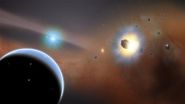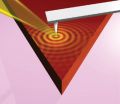(Press-News.org) Astronomers using the Atacama Large Millimeter/submillimeter Array (ALMA) telescope have discovered the splattered remains of comets colliding together around a nearby star; the researchers believe they are witnessing the total destruction of one of these icy bodies once every five minutes.
The "smoking gun" implicating this frosty demolition is the detection of a surprisingly compact region of carbon monoxide (CO) gas swirling around the young, nearby star Beta Pictoris.
"Molecules of CO can survive around a star for only a brief time, about 100 years, before being destroyed by UV radiation," said Bill Dent, a researcher at the Joint ALMA Office in Santiago, Chile, and lead author on a paper published in the journal Science online at the Science Express website. "So unless we are observing Beta Pictoris at a very unusual time, then the carbon monoxide we observed must be continuously replenished."
Comets and other icy bodies trap vast amounts of CO and other gases in their frosty interiors. When these objects collide, as is common in the chaotic environment around a young star, they quickly release their stored gases. If these collisions were occurring randomly in this system, then the CO would be more or less evenly distributed.
But the new images from ALMA show something else: a single compact clump of CO approximately 13 billion kilometers (8 billion miles) from the star -- or about three times the distance of Neptune to the Sun. "This clump is an important clue to what's going on in the outer reaches of this young planetary system," says Mark Wyatt, an astronomer at the University of Cambridge and coauthor on the paper.
Earlier observations of Beta Pictoris with other telescopes revealed that it is surrounded by a large disk of dusty debris and harbors at least one planet orbiting approximately 1.2 billion kilometers (750 million miles) from the star.
The new ALMA data suggest, however, that there may be a second, as-yet-undetected planet orbiting much farther out. The gravity from such a planet would shepherd millions of cometary bodies into a relatively confined area. A similar phenomenon is seen in our own Solar System where the planet Jupiter keeps a group of so-called Trojan asteroids in a confined orbit around the Sun.
"To get the amount of CO we observed -- which is equal to about one-sixth the mass of Earth's oceans -- the rate of collisions would be truly startling, with the complete destruction of a large comet once every five minutes," noted Aki Roberge, an astronomer at NASA's Goddard Space Flight Center in Greenbelt, Maryland, and coauthor on the paper. "To get this number of collisions, this would have to be a very tight, massive swarm."
The astronomers propose an alternate possibility for the origin of this swarm of icy bodies; two Mars-size icy planets smashing together within the past million years could have produced the compact, cometary debris around the star. Such an occurrence, however, would be rare and there is a low likelihood that it could have occurred recently enough for the remnants to still be so concentrated.
Both possibilities, however, give astronomers reason to be optimistic that there are many more planets waiting to be found around Beta Pictoris, which is located a relatively nearby 63 light-years from Earth in the southern constellation Pictor.
ALMA's unprecedented resolution and sensitivity enabled the astronomers to detect the faint millimeter-wavelength light emitted by both the dust grains and CO in the system.
"And carbon monoxide is just the beginning; there may be other more complex pre-organic molecules released from these icy bodies," adds Roberge.
The astronomers hope that further observations with ALMA will shed more light on this system and help us understand what conditions were like during the formation of our own Solar System.
INFORMATION:
ALMA, an international astronomy facility, is a partnership of Europe, North America and East Asia in cooperation with the Republic of Chile. ALMA construction and operations are led on behalf of Europe by ESO, on behalf of North America by the National Radio Astronomy Observatory (NRAO), and on behalf of East Asia by the National Astronomical Observatory of Japan (NAOJ). The Joint ALMA Observatory (JAO) provides the unified leadership and management of the construction, commissioning and operation of ALMA.
The National Radio Astronomy Observatory is a facility of the National Science Foundation, operated under cooperative agreement by Associated Universities, Inc.
ALMA sees icy wreckage in nearby solar system
Possible hidden planet causing rapid-fire cometary collisions
2014-03-06
ELSE PRESS RELEASES FROM THIS DATE:
Galactic gas caused by colliding comets suggests mystery 'shepherd' exoplanet
2014-03-06
Astronomers exploring the disk of debris around the young star Beta Pictoris have discovered a compact cloud of carbon monoxide located about 8 billion miles (13 billion kilometers) from the star. This concentration of poisonous gas – usually destroyed by starlight – is being constantly replenished by ongoing rapid-fire collisions among a swarm of icy, comet-like bodies.
In fact, to offset the destruction of carbon monoxide (CO) molecules around the star, a large comet must be getting completely destroyed every five minutes, say researchers.
They suggest the comet swarm ...
Vitamin D increases breast cancer patient survival
2014-03-06
Breast cancer patients with high levels of vitamin D in their blood are twice as likely to survive the disease as women with low levels of this nutrient, report University of California, San Diego School of Medicine researchers in the March issue of Anticancer Research.
In previous studies, Cedric F. Garland, DrPH, professor in the Department of Family and Preventive Medicine, showed that low vitamin D levels were linked to a high risk of premenopausal breast cancer. That finding, he said, prompted him to question the relationship between 25-hydroxyvitamin D — a metabolite ...
UT Arlington study links BPA and breast cancer tumor growth
2014-03-06
UT Arlington biochemists say their newly published study brings researchers a step closer to understanding how the commonly used synthetic compound bisphenol-A, or BPA, may promote breast cancer growth.
Subhrangsu Mandal, associate professor of chemistry/biochemistry, and Arunoday Bhan, a PhD student in Mandal's lab, looked at a molecule called RNA HOTAIR. HOTAIR is an abbreviation for long, non-coding RNA, a part of DNA in humans and other vertebrates. HOTAIR does not produce a protein on its own but, when it is being expressed or functioning, it can suppress genes that ...
NASA's TRMM satellite images show California soaker moved eastward
2014-03-06
The Tropical Rainfall Measuring Mission or TRMM satellite provided a look at the rainfall associated with the large storm system that brought soaking rains to California on Feb. 28 and Mar. 1. Satellite imagery created at NASA shows the movement of the storm from the U.S. West Coast to the East Coast.
At NASA's Goddard Space Flight Center in Greenbelt, Md. images were created using data from the TRMM Microwave Imager (TMI) instrument that showed the movement of recent stormy weather from California's Pacific Ocean coast to the Atlantic Coast. TRMM is a satellite managed ...
NASA's THEMIS discovers new process that protects Earth from space weather
2014-03-06
In the giant system that connects Earth to the sun, one key event happens over and over: solar material streams toward Earth and the giant magnetic bubble around Earth, the magnetosphere helps keep it at bay. The parameters, however, change: The particles streaming in could be from the constant solar wind, or perhaps from a giant cloud erupting off the sun called a coronal mass ejection, or CME. Sometimes the configuration is such that the magnetosphere blocks almost all the material, other times the connection is long and strong, allowing much material in. Understanding ...
Crystals ripple in response to light
2014-03-06
Light can trigger coordinated, wavelike motions of atoms in atom-thin layers of crystal, scientists have shown. The waves, called phonon polaritons, are far shorter than light waves and can be "tuned" to particular frequencies and amplitudes by varying the number of layers of crystal, they report in the early online edition of Science March 7.
These properties - observed in this class of material for the first time - open the possibility of using polaritons to convey information in tight spaces, create images at far finer resolution than is possible with light, and manage ...
Plasma plumes help shield Earth from damaging solar storms
2014-03-06
The Earth's magnetic field, or magnetosphere, stretches from the planet's core out into space, where it meets the solar wind, a stream of charged particles emitted by the sun. For the most part, the magnetosphere acts as a shield to protect the Earth from this high-energy solar activity.
But when this field comes into contact with the sun's magnetic field — a process called "magnetic reconnection" — powerful electrical currents from the sun can stream into Earth's atmosphere, whipping up geomagnetic storms and space weather phenomena that can affect high-altitude aircraft, ...
Researchers calculate how river networks move across a landscape
2014-03-06
Large river networks — such as those that funnel into the Colorado and Mississippi rivers — may seem to be permanent features of a landscape. In fact, many rivers define political boundaries that have been in place for centuries.
But scientists have long suspected that river networks are not as static as they may appear, and have gathered geologic and biological evidence that suggest many rivers have been "rewired," shifting and moving across a landscape over millions of years.
Now researchers at MIT and the Swiss Federal Institute of Technology (ETH Zurich) have developed ...
Warmer temperatures push malaria to higher elevations
2014-03-06
Researchers have debated for more than two decades the likely impacts, if any, of global warming on the worldwide incidence of malaria, a mosquito-borne disease that infects more than 300 million people each year.
Now, researchers from the London School of Hygiene & Tropical Medicine and the University of Michigan, with colleagues, are reporting the first hard evidence that malaria does—as had long been predicted—creep to higher elevations during warmer years and back down to lower altitudes when temperatures cool.
The study, due to be published in Science and based ...
Scientists create detailed picture of protein linked to learning, pain and brain disorders
2014-03-06
LA JOLLA, CA, and NASHVILLE, TN – March 6, 2014 – Researchers at The Scripps Research Institute (TSRI) and Vanderbilt University have created the most detailed 3-D picture yet of a membrane protein that is linked to learning, memory, anxiety, pain and brain disorders such as schizophrenia, Parkinson's, Alzheimer's and autism.
"This receptor family is an exciting new target for future medicines for treatment of brain disorders," said P. Jeffrey Conn, PhD, Lee E. Limbird Professor of Pharmacology and director of the Vanderbilt Center for Neuroscience Drug Discovery, who ...
LAST 30 PRESS RELEASES:
New technique lights up where drugs go in the body, cell by cell
New study finds movement of fishing fleets can reveal shifts in marine ecosystems
Embargoed: New evidence points to potential treatment for vascular dementia
Study uncovers disrupted brain balance in alcohol dependence
Working in groups can help Republicans and Democrats agree on controversial content moderation online
Structural findings reveal how distinct GPCR ligands create different levels of activation
Anything-goes “anyons” may be at the root of surprising quantum experiments
UC review: Maximizing workplace opportunity for veterans
From generation to complex control: Metasurfaces make perfect vortex beams "within reach"
Thin-film lithium niobate-based detector: recent advances and perspectives
Exploring why some people may tend to persistently make bad choices
How cells balance their protein levels
Nirsevimab vs RSVpreF vaccine for RSV–related hospitalization in newborns
Effectiveness and impact of maternal RSV immunization and nirsevimab on medically attended RSV in US children
AI gives scientists a boost, but at the cost of too many mediocre papers
Next-generation vision model maps tree growth at sub-meter precision
Genes aren’t destiny for inherited blindness, study shows
MIT study: High-fat diets make liver cells more likely to become cancerous
Exposure to multiple fine particulate matter components and incident depression in the US Medicare population
Risk of burdensome health care spending over time in the US
Nirsevimab against hospitalizations and emergency department visits for lower respiratory tract infection in infants
New microfluidics technology enables highly uniform DNA condensate formation
A new strategy for immune tolerance
Super Mario Bros. help fight burnout: New study links classic games to boosted happiness
Deepest gas hydrate cold seep ever discovered in the arctic: International research team unveils Freya Hydrate Mounds at 3,640 m depth.
Integrating light and structure: Smarter mapping for fragile wetland ecosystems
ACA-SIM: A robust way to decode satellite signals over complex waters
Probiotics can restore gut microbiome in breastfed infants
AI could help predict nutrition risks in ICU patients, study finds
Federal EITC has unexpected result, researchers say – it decreases domestic violence
[Press-News.org] ALMA sees icy wreckage in nearby solar systemPossible hidden planet causing rapid-fire cometary collisions







